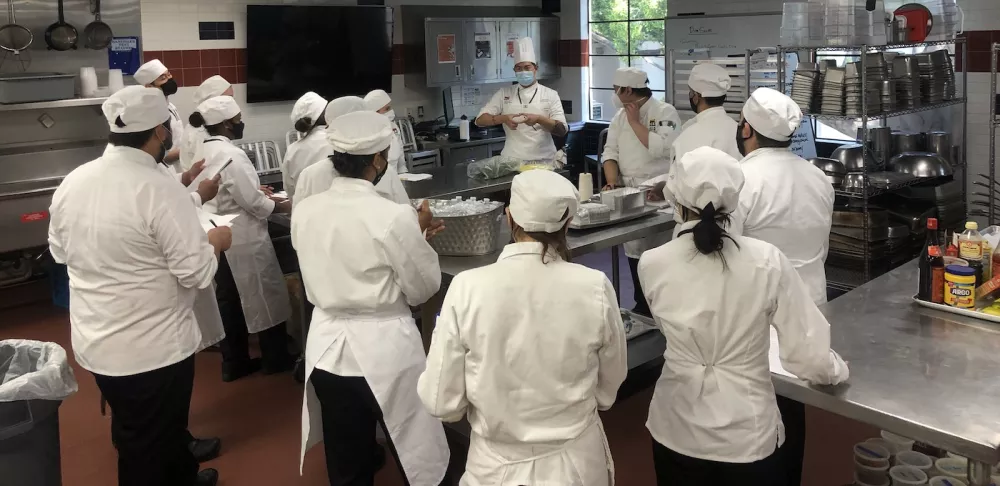Culinary Arts Chef-Instructor Alan Kang shows students how to make dim sum and talks about his personal connection with this communal Chinese meal.
Students at ICE's Los Angeles campus had the opportunity to participate in a four-hour dim sum workshop, the kick-off to our new extracurricular Deep Dive series, exploring ingredients, techniques and cuisines to broaden students' horizons beyond the classroom.
Born to Taiwanese parents, Chef Alan Kang grew up at his family’s haute Chinese restaurant in Pasadena. After teaching the lesson on Chinese cuisine, Chef Alan sought to expand on its vastness with a dim sum demonstration. “It is one of my favorite memories as a kid and even now as an adult, getting dim sum with friends is something I do often,” he says.
Dim sum is a Cantonese term for the steamed, baked and fried foods served as small plates — and it is not limited to dumplings. In addition to boiled, fried and steamed dumplings, like the shu mai taught in ICE's Culinary Arts program, another dim sum bite is turnip cake. “Turnip cake is one of my favorite dim sum items to eat, but I don't know if it's as popular as the other mainstream dishes so I wanted to spotlight it,” Chef Alan says.
He taught students how to make turnip cake, dumplings, shrimp balls and cheung fun, a rice noodle roll. “Shrimp balls are fun, and I wanted to have a recipe that was easy for students at any skill level or program,” he says.
Students worked in teams and were able to experiment with the recipes, adding their own creativity and ingredients that pleased their palate. When all the dishes were presented, just like at a regular dim sum gathering, students dined on the delights of their hard work. “There’s just something very communal about eating a bunch of small plates at a table and catching up,” Chef Alan says.
Dim Sum Dishes
- Dumplings: Making dumplings is not easy. Don't give up or be too discouraged if they don't come out with perfect pleats the first time around. Practice makes perfect.
- Cheung Fun: Always give your batter a really good stir before each time you make it, otherwise the rice flour will sit at the bottom of the bowl.
- Shrimp Balls: Trimming off the excess spring rolls for the shrimp balls is optional; it's up to you if you want the extra crunchy bits!
Here's one of Chef Alan's recipes from the demo.

Ingredients
- 1 pound shrimp, peeled and deveined
- 2 ounces yellow garlic chive, minced
- 1 egg white, lightly beaten
- 1 teaspoon salt
- 1 teaspoon sugar
- 1 tablespoon corn starch
- 1/2 teaspoon sesame oil
- 1 tablespoon lard
- 1/2 teaspoon white pepper, ground
- Spring roll wrappers, as needed
Directions
- In a food processor, add half of the shrimp, yellow garlic chive, egg white, salt, sugar, cornstarch, sesame oil, lard, and white pepper. Blend until you form a shrimp paste. Place the other half of the shrimp in a kitchen aid stand mixer with a paddle attachment and beat until the shrimp is broken into pieces. Combine.
- Fold the spring roll wrappers and cut into ¼-inch-thick slices. Wet your hands with water and form the shrimp mixture into 1 tablespoon-sized balls. Roll the shrimp balls into the spring roll strips until fully covered. Trim off any excess strips and deep fry the balls until golden brown, about 5 minutes.
- Drain on a paper towel and serve with Mae Ploy Sweet Chili Sauce.
Study Asian cuisine in Culinary Arts at ICE.
Get ICE Chef King Phojonakang's soup dumpling recipe.




